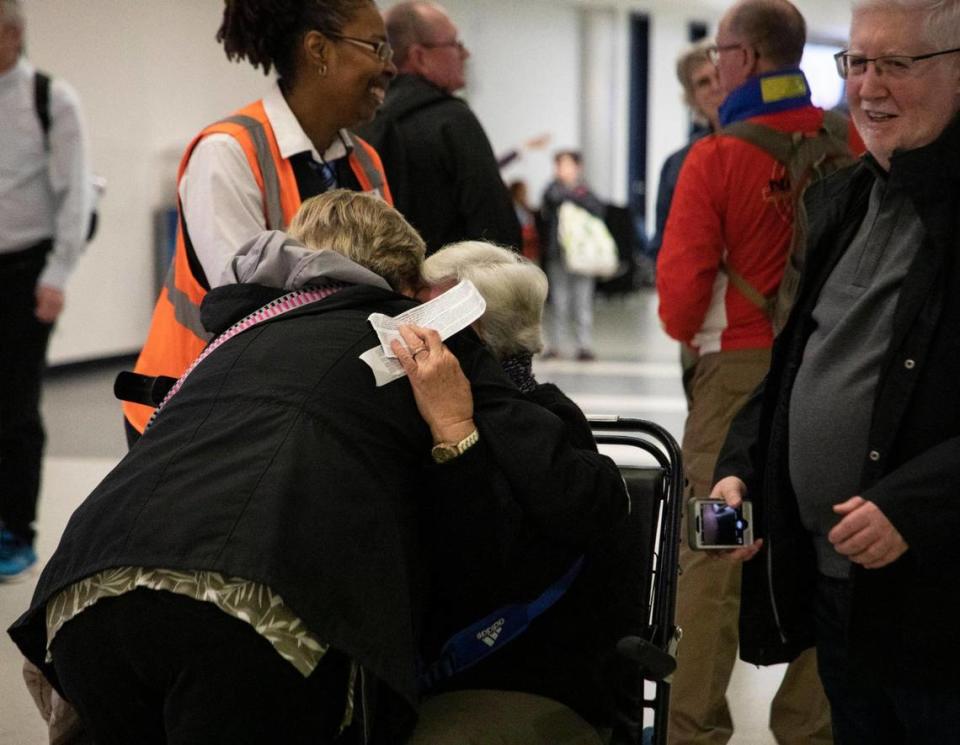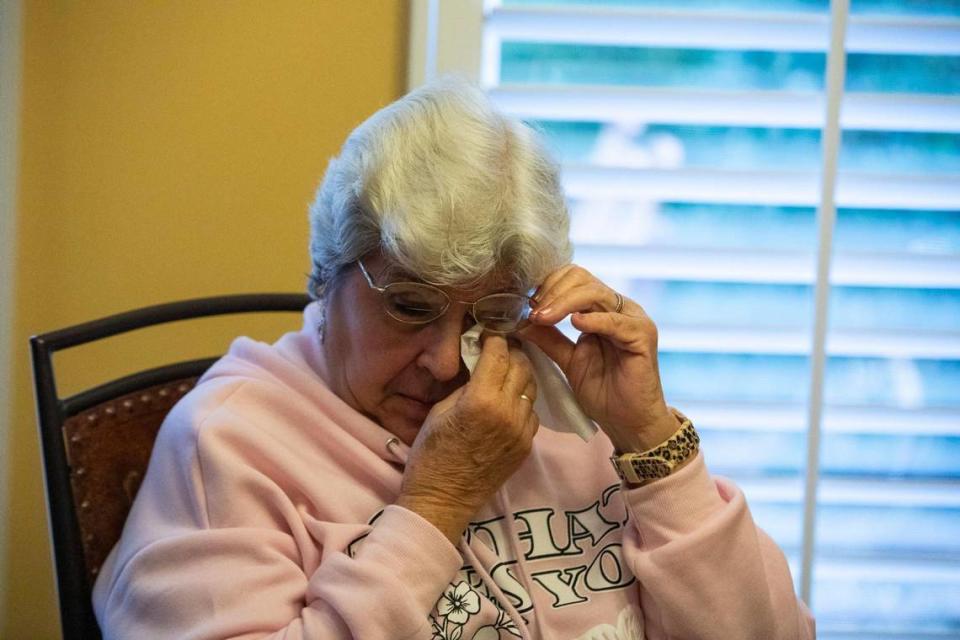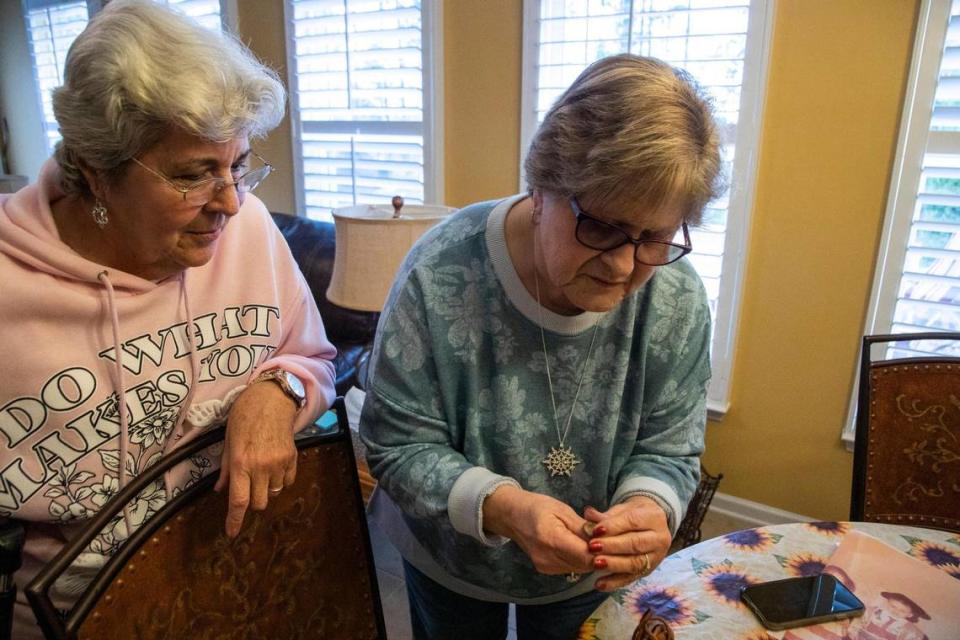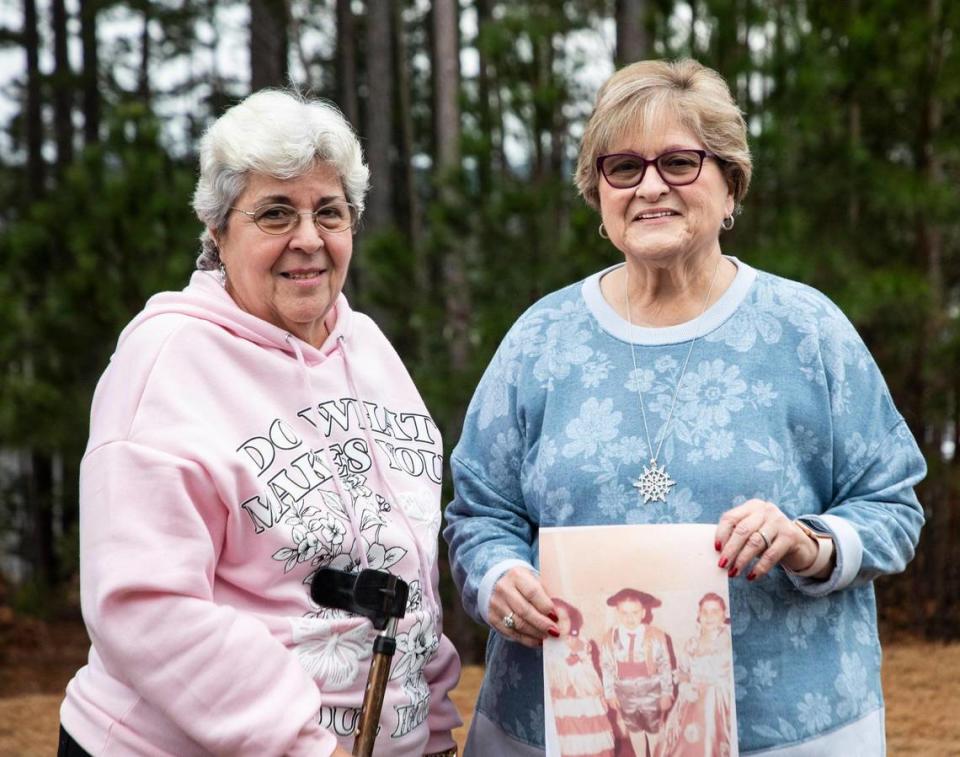How two friends from Cuba lost touch, then reunited in the U.S. — after 60 years apart
Her iPhone rang, and Terry Diego made a face.
The call was coming from an unknown number, and Terry doesn’t answer calls from unknown numbers. Her husband Emilio does, though, so she passed her device to him.
This was not even two years ago. It had, to that point, been just another ordinary day of enjoying retirement for the Diegos, who live in the Sun City Carolina Lakes community in Indian Land, South Carolina. But Terry was about to get the biggest surprise she’d had in her seven decades on earth.
“I picked up the phone,” Emilio recalls, “and I heard a lady speak in Spanish. She appeared to be a bit distraught. She was very anxious. She was asking for Teresa” — Terry’s given name — “saying, ‘I’m her friend Lilly.’ I said, ‘Wait a minute.’ I went to my wife and gave her the phone, and I said, ‘This is Lilly calling you.’ She looked at me like, What the hell are you talking about? You’re pulling my leg.”
The only Lilly she knew was a Lilly who she hadn’t heard from in about 30 years.
Who she hadn’t seen in the flesh since the summer of 1962, when Terry’s mother and father left their home country of Cuba with barely more than the clothes on their backs to start a new life in the United States.
Since they were 11 years old.
When Terry came onto the phone, Lilly was so overcome with emotion that she could barely speak. Terry, meanwhile, couldn’t contain herself; she kept asking Lilly where she’d been all these years, what had happened to her, how she’d managed to finally track her down.
“I was in disbelief,” Terry recalls. “I never thought I would hear from her again. It was a lot of years that had passed. I figured she had moved out of the country, or she was living someplace else in Cuba. ... I thought maybe she was dead!”
The women both laugh.
They’re sitting at a table in the Diegos’ breakfast area in mid-January, six days into a month-long visit that started with an emotional reunion — after 60 years apart — at Charlotte Douglas International Airport, upon Lilly’s arrival from her new home in Phoenix.
It’s been almost one month since Lilly came to the U.S. legally, after a yearslong effort to leave the long-suffering Caribbean nation.
And here’s an interesting wrinkle: If not for her childhood friend Terry, Lilly might still be stuck there.

‘We cried a lot when we said goodbye’
Lilly and Terry met when they were 5-year-old kindergartners, in 1956, at a time when Havana was a gleaming, lively jewel of a metropolis. Their comfortably middle-class families lived just a block and a half away, and once they became friends, Lilly could often be found at Terry’s, or vice-versa, playing with dolls, playing house — and just generally spending as much time together as they could.
But following the Cuban Revolution and Fidel Castro’s rise to power in 1959, the country became a one-party Communist state.
As the sweet existence their families had enjoyed slowly began to sour, Terry’s parents hatched a plan to seek asylum in the U.S., where their son (15 years Terry’s elder) was already living with his wife and child.
Once everything lined up for them to leave, Terry’s mother threw a party for her daughter right before they left — one that Lilly, naturally, would attend. During the gathering, Terry cut off a small lock of her hair and gave it to Lilly; Lilly gifted Terry a tiny coin purse adorned with the words “Habana” and “Cuba” that she’d bought at Woolworth’s, and into which she’d placed a small handful of Cuban coins.
When she handed it to her, Lilly told Terry: “Never forget your country.”
“We cried a lot when we said goodbye,” Lilly says, her voice shaking, as she recalls the moment in striking detail.
Still, even at just 11 years old, Terry says she felt that two things were certain: 1) That they would never see each other again, unless Lilly left Cuba, and 2) That they would always keep in touch.
Her family left Havana on July 2, 1962. On their way out of the country, Cuban authorities confiscated a bracelet of her mother’s and a pair of earrings Terry had worn for the trip. She and her parents arrived in Miami with a bag carrying just three changes of clothing for each of them.
The next month, they migrated to New York City, where her father would go on to spend his working life as a cutter and a tailor at a men’s store.
Phone calls were cost-prohibitive, but Terry and Lilly maintained a steadfast connection by mail. Throughout their preteen and teenage years, they wrote letters to each other pretty much every week, about boys, about school, about The Beatles and other music they loved. They exchanged photographs of each other. Terry would send American magazines, U.S. currency, Chiclets gum, and Gillette razors for Lilly to use on her legs and for her dad to use on his face.
Their pen pal-ing continued into their 20s, as they found husbands and got married, and into their 30s, as they both went through pregnancies and had children. It maybe wasn’t quite as frequent — and it certainly was slow, with the delivery process often taking a month and sometimes even two — but they kept at it. Just like Terry had always figured they would.
Until one day in the early ’90s, when it suddenly just stopped.

Their respective disappearances? A mystery.
From Terry’s perspective, the letters she was sending to Lilly started going into a black hole.
She was still mailing the correspondence to the same address Lilly had lived at since she was a baby. But the replies abruptly stopped. After numerous attempts over the course of a reasonably long period of time, she gave up.
From Lilly’s perspective, the letters she was sending to Terry started coming back to her, every time. And they came with some words on the envelope that she hadn’t written: “Unknown address.” Eventually, she gave up, too.
It was a mystery that was not solvable at the time, since Google and Facebook were still years away. So they just moved on with their lives.
Lilly was divorced by that time, still living in her childhood home, working for an artisan selling handicrafts to tourists. She had dreams of leaving Cuba for the U.S. but felt obligated to stay because her mother’s health was declining. Terry was a training administrator at a lighting company on Long Island, married to a man who worked for an insurance company on Wall Street — someone she’d known since she was 11 and brand-new to New York City.
Probably the closest they came to reconnecting was in 2011, when Lilly unearthed an old letter in which Terry had included a phone number for their home in Coram on Long Island. Lilly called it, but the person who answered told her she had the wrong number.
Terry and Emilio, in fact, had made a big change, moving from New York to Charlotte when Emilio’s company offered him a job transfer.
In the coming years, meanwhile, Lilly’s life would change dramatically, too. Her mother died in 2014, cracking open the door for Lilly to start thinking about how she might finally be able to flee to the U.S. to join her son, who’d been there since 2000. It opened even wider in 2017, after she married a longtime friend who was able to make it out of the country that year.
Then, in 2018, Cuban citizens finally started to gain consistent, open access to the internet for the first time in the country’s history.
The tools were finally there for Lilly. But it took a while for her to utilize them.
In 2020, Terry made a fresh attempt to solve the mystery of her friend’s disappearance from her life by posting a plea for help finding her in the Facebook group All Things Cuban. No one had any clues to provide. Barely three months later, though, in early 2021, a friend told Lilly that she had found a Facebook profile belonging to a woman she was sure was Terry.
Lilly didn’t know how to handle the news. Like, literally had trouble processing it. She says she waited more than two weeks to do anything about it because she was afraid of how Terry might react.
When she finally did, all of her questions — including the big one: “How in the world did we lose track of each other in the early 1990s?” — would be solved.

‘I will always be grateful to them’
Calls between the U.S. and Cuba cost a small fortune, so they kept the first conversation to just a half an hour, pledging to switch to free options like WhatsApp going forward.
But it was enough time for some a-ha moments.
For one, Lilly was able to deduce that her stepmother was in fact a wicked one. Lilly was still living at the same address she did when they were childhood friends, just like she had been in the ’90s. In other words, Terry’s letters were making it to the house back then, Lilly says, it’s just that her stepmother — who Lilly says was never nice to her — was getting rid of them without saying anything to Lilly.
As a result, Lilly never saw the letters Terry had written that explained she and Emilio had moved to a new address. That’s why Lilly’s letters to Terry had started coming back with “unknown address” stamps on them.
Oh, and that time Lilly had tried to call Terry’s Coram phone number in 2011? Turns out, if she had dialed that number just a few short months sooner, Terry might have answered. (Or, more likely, Emilio would have, since Terry doesn’t pick up if she doesn’t know who’s calling.)
Practically overnight, they were close friends again. They’ve been in contact almost every day since, at least via text.
Pretty early on, Lilly explained her desire to leave Cuba, about her husband and her son. But there were significant obstacles: COVID, for starters, because of how much it had slowed down the process for Cubans wanting to legally leave; then also — well, neither she nor her family could afford to make it happen.
Terry shrugged the latter issue off. She and Emilio told her they wanted to pay for Lilly’s accommodations in Guyana, where she spent about three weeks between November and December while waiting for the U.S. Embassy to approve her visa; for her airfare to there and to the U.S.; and whatever other expenses she needed help with to get to Arizona.
Because that’s what friends do.
“We worked all our lives, we saved money, and we could do it,” says Terry, whose Cuban accent seems to be having a wrestling match with her Long Island accent. “Sometimes in your life you have to do a good deed. And you just don’t do a lot of them. You just do a big one. And this is the big one.”
She laughs, looks at her friend, and says: “Just don’t leave, ’cause I won’t do it again.”
Lilly laughs back, but quickly turns serious. “I will always be grateful to them,” she says, struggling a little bit because of her slightly limited English, but mainly because she’s fighting back tears. “Always.”
“It was like a magic story for me,” Lilly continues, referring to the chain of events that led them to be sitting here at this table together, her now 71 and Terry having turned 72 on Jan. 29. “Something unbelievable. After so many years. But ... I always thought I was going to find her. I don’t know if in this world or up there, but I was going to find her.
“Thank God it was down here.”


 Yahoo Movies
Yahoo Movies 
